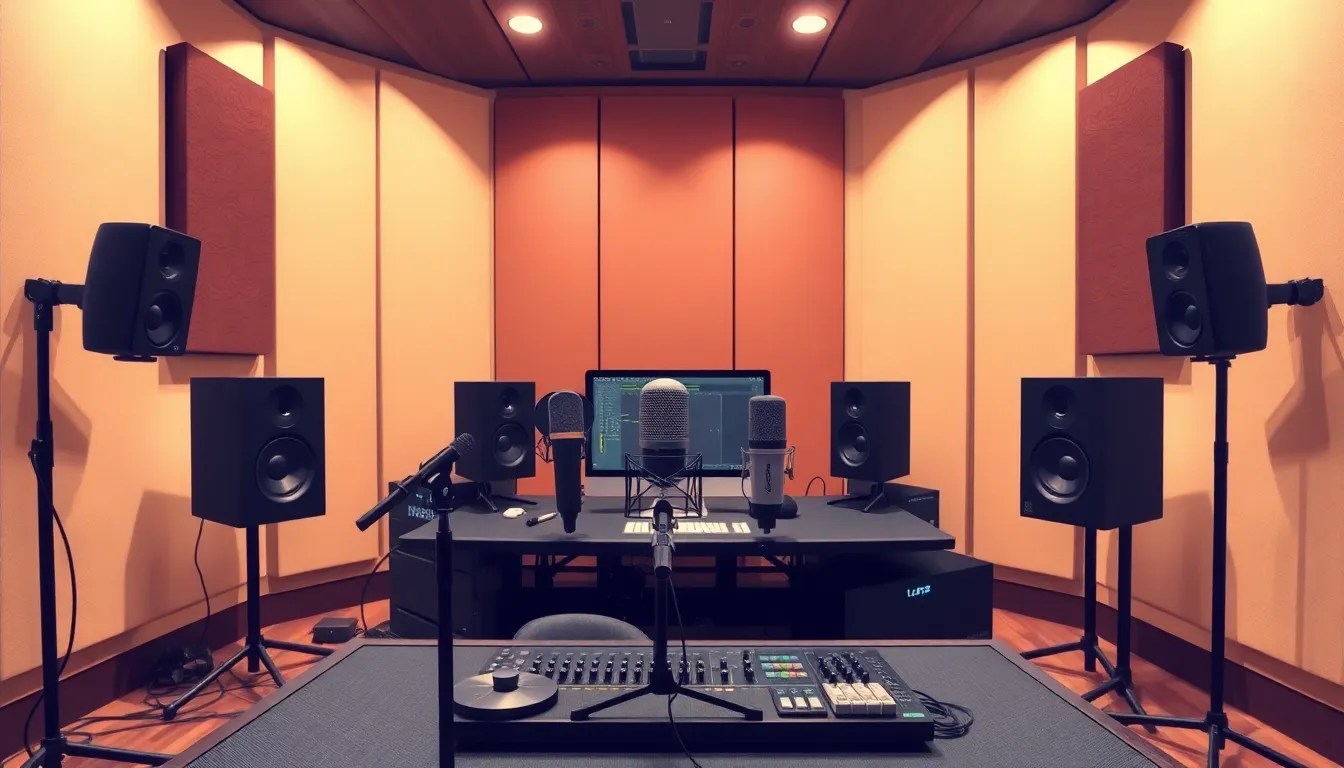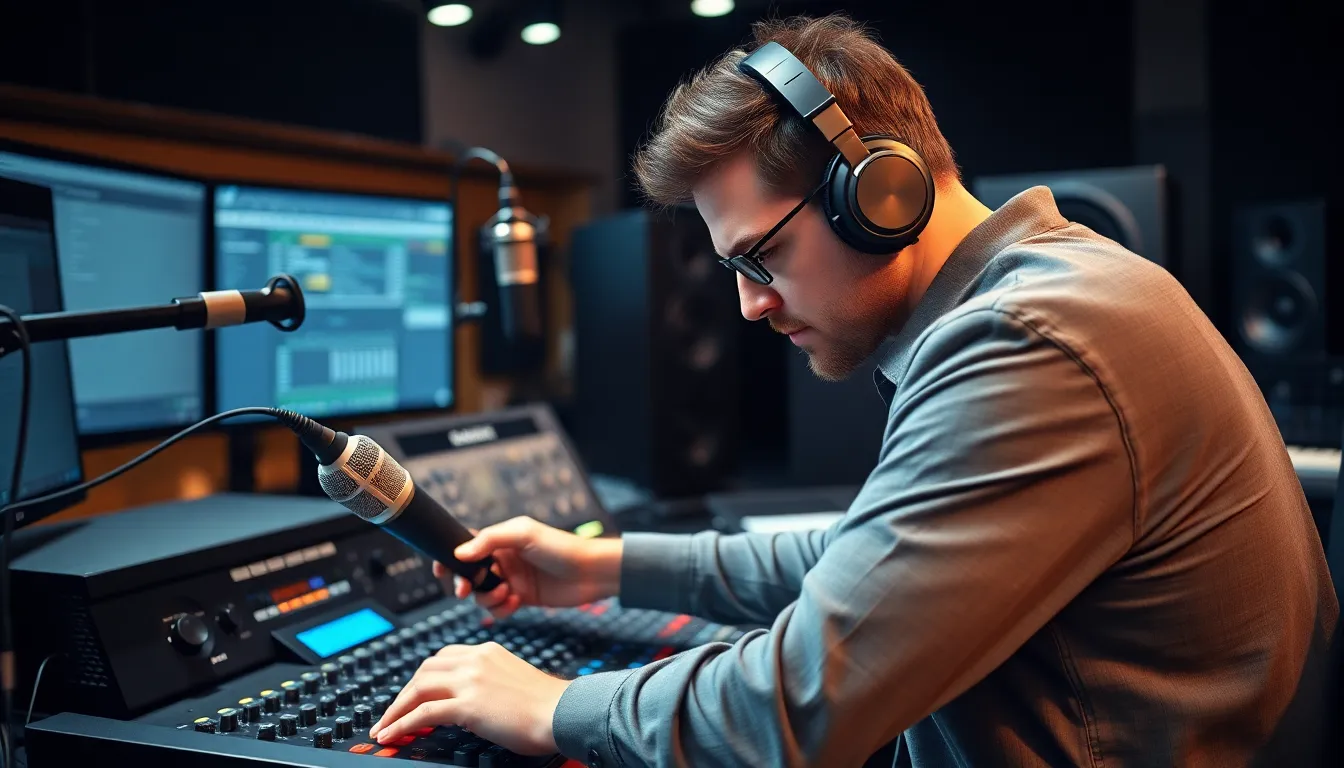In a world where sound can make or break an experience, pro audio technology stands as the unsung hero behind every epic concert and heart-pounding movie scene. It’s not just about turning knobs and adjusting levels; it’s about creating an auditory journey that leaves audiences spellbound. Whether it’s the crisp clarity of a live band or the deep rumble of a cinematic explosion, the right audio gear can elevate any production from ordinary to extraordinary.
But let’s face it, navigating the sea of microphones, mixers, and monitors can feel like trying to find a needle in a haystack—while blindfolded. Fear not! This article dives into the essentials of pro audio technology, breaking down the complexities with a touch of humor and a whole lot of expertise. Get ready to unlock the secrets of sound and discover how the right equipment can transform any project into a masterpiece.
Table of Contents
ToggleOverview of Pro Audio Technology
Pro audio technology encompasses a wide range of equipment and techniques designed to capture, mix, and reproduce sound with exceptional quality. Professionals in music production, broadcasting, and live events rely on this technology to deliver a polished auditory experience. High-quality microphones, audio interfaces, mixing consoles, and speaker systems play critical roles in production settings.
Microphones convert sound waves into electronic signals. Various types such as dynamic, condenser, and ribbon fulfill different purposes, like studio recording or live performances. Audio interfaces serve as the bridge between analog signals and digital audio workstations. They facilitate higher sample rates and bit depths, ensuring precise sound capture.
Mixing consoles, whether analog or digital, combine multiple audio signals into one cohesive output. These devices allow engineers to adjust levels, apply effects, and manipulate sound in real-time. Essential features include built-in EQs, faders, and send/return effects paths.
Speakers and monitors deliver the final audible product to audiences. Studio monitors provide accurate sound reproduction, enabling accurate mixing and mastering. In contrast, PA systems ensure clear sound across large venues, accommodating higher volume levels without distortion.
Digital audio workstations represent software solutions for recording, editing, and producing sound. Popular DAWs include Pro Tools, Ableton Live, and Logic Pro. These programs offer extensive features for sound manipulation, virtual instruments, and effects.
The broad spectrum of pro audio technology serves various purposes, enhancing sound quality across different mediums. Understanding each component facilitates better decision-making for audio professionals and enthusiasts.
Key Components of Pro Audio Systems

Pro audio systems consist of various crucial components that work together to create high-quality sound. These elements play distinct roles that enhance audio clarity and overall experience in live events or studio recordings.
Microphones
Microphones capture sound, serving as the first point in the audio chain. Dynamic microphones excel in live settings due to their durability and resistance to feedback. In contrast, condenser microphones deliver more sensitivity and detail, making them ideal for studio recordings. Selectivity in choosing the right microphone can significantly impact the final audio quality. For instance, a shotgun microphone specializes in isolating sound from specific directions, beneficial for film production. Understanding microphone types and applications helps audio professionals make informed choices.
Audio Interfaces
Audio interfaces bridge analog signals from microphones and instruments to digital formats recognized by computers. Quality audio interfaces minimize latency and enhance sound fidelity during recording and playback. Many models offer multiple input channels, allowing for simultaneous recording of various sources, such as vocals and instruments. USB and Thunderbolt connections provide different speed capabilities; choosing the appropriate type depends on the specific audio needs. Reliability and compatibility with digital audio workstations influence the effectiveness of audio interfaces in pro audio setups.
Speakers and Monitors
Speakers and monitors play a pivotal role in audio reproduction, ensuring accurate sound delivery to listeners. Studio monitors are designed to provide a flat frequency response, allowing sound engineers to hear recordings without coloration. Regular speakers, often used for casual listening, may enhance certain frequencies, altering the sound experience. When setting up a system, positioning and acoustics matter; optimal placement can significantly improve sound quality and clarity. Professionals prioritize monitors that suit their specific needs, as this leads to better mixing and mastering results.
Advances in Pro Audio Technology
Pro audio technology continues to evolve, leading to remarkable improvements in sound quality and user experience. Innovations in digital signal processing and wireless technology highlight this progress.
Digital Signal Processing
Digital signal processing (DSP) enhances audio performance through advanced algorithms. These algorithms manipulate sound waves and enable real-time effects such as reverb or compression. DSP plays a pivotal role in minimizing latency, ensuring that audio signals remain synchronized, especially during live performances. Additionally, this technology allows for greater precision in equalization, enabling sound engineers to adjust frequencies more effectively. Industries such as film and music production leverage DSP to create immersive soundscapes. By improving audio fidelity and clarity, it transforms listening experiences in various contexts.
Wireless Technology
Wireless technology revolutionizes pro audio by offering flexibility and mobility. Wireless microphones utilize UHF or digital frequency bands, delivering high-quality sound without cumbersome cables. This freedom enhances stage movement for performers, allowing for dynamic presentations. Furthermore, wireless audio transmission systems facilitate seamless connections between different sound components in both small venues and large auditoriums. Innovations in battery life and signal reliability have made wireless solutions increasingly dependable. Users benefit from the convenience of setup and the reduction of trip hazards, making wireless technology integral to modern audio setups.
Applications of Pro Audio Technology
Pro audio technology finds extensive applications across various fields, enhancing sound quality and delivering immersive experiences.
Live Sound Reinforcement
Live sound reinforcement involves using pro audio technology for concerts and events. Sound engineers employ high-quality microphones, mixing consoles, and speaker systems to ensure optimal sound delivery. Specific setups include line arrays for large venues or portable PA systems for smaller gatherings. Engineers often adjust sound levels in real-time to adapt to audience feedback and venue acoustics. Moreover, wireless microphones add mobility for performers, allowing freedom of movement on stage. This flexibility enhances the overall experience, enabling audiences to engage fully with live performances.
Studio Recording
Studio recording utilizes pro audio technology to capture sound with precision. Musicians and producers rely on high-fidelity microphones and audio interfaces for recording sessions. Dynamic microphones fit well for loud instruments like drums, while condenser microphones excel with vocals and acoustic instruments. Mixing consoles blend multiple tracks, allowing for creative adjustments that transform raw recordings into polished works. Studio monitors provide accurate sound reproduction, facilitating essential mixing decisions. Recording engineers prioritize acoustics and room treatment to eliminate unwanted noise and enhance audio clarity.
Broadcast and Streaming
Broadcast and streaming benefit immensely from pro audio technology, providing high-quality audio to audiences worldwide. Professional-grade microphones deliver clear voiceovers and interviews, while audio interfaces ensure minimal latency. Sound engineers use mixing consoles for real-time sound manipulation, enhancing listener experiences in both radio and television broadcasting. Live streaming platforms rely on high-quality sound systems to maintain audio fidelity during transmissions. Additionally, audio compression techniques help deliver superior sound quality while optimizing bandwidth. This combination of technologies ensures that audiences receive clear and engaging sound, regardless of the medium.
Pro audio technology is essential for anyone looking to elevate their auditory experiences. By understanding the intricacies of microphones, audio interfaces, and mixing consoles, professionals can create soundscapes that resonate with audiences. Innovations in digital signal processing and wireless technology continue to enhance sound quality and flexibility, making it easier to deliver exceptional audio in various settings.
Whether it’s for live events, studio recordings, or broadcasting, the right tools and techniques play a pivotal role in achieving clarity and impact. Embracing these advancements not only improves the quality of sound but also enriches the overall experience for listeners. As technology evolves, staying informed will empower audio professionals to make choices that truly resonate.




